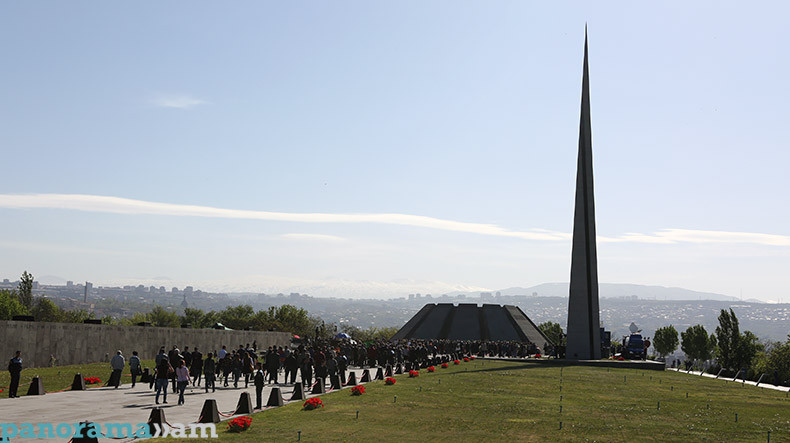
Armenians worldwide commemorate genocide victims
Today is the 102nd anniversary of the commemoration of the Armenian Genocide, also known as Medz Yeghern (Մեծ Եղեռն.) Every year, hundreds of thousands visit Tsitsernakaberd, Armenian Genocide Victims Memorial in Yerevan, to pay tribute to the victims of the genocide.
The Armenian president, members of the Government, MPs, foreign diplomats, representatives of Armenian overseas communities and guests from other countries visit the memorial every year.
According to the RA MFA bulletin, when WWI erupted, the Young Turks government, hoping to save the remains of the weakened Ottoman Empire, adopted a policy of Pan Turkism – the establishment of a mega Turkish empire comprising of all Turkic-speaking peoples of the Caucasus and Central Asia extending to China, intending also to Turkify all ethnic minorities of the empire. The Armenian population became the main obstacle standing in the way of the realization of this policy.
Although the decision for the deportation of all Armenians from the Western Armenia (Eastern Anatolya) was adopted in late 1911, the Young Turks used WWI as a suitable opportunity for its implementation.
There were an estimated two million Armenians living in the Ottoman Empire on the eve of WWI. Approximately one and a half million Armenians perished between 1915 and 1923. Another million found shelter abroad or Islamized.
On 24th of April in 1915, the first phase of the Armenian massacres began with the arrest and murder of nearly hundreds intellectuals, mainly from Constantinople, the capital of Ottoman Empire (now Istanbul in present Turkey's capital). Subsequently, Armenians worldwide commemorate the April 24th as a day that memorializes all the victims of the Armenian Genocide.
The second phase of the ‘final solution’ appeared with the conscription of some 60.000 Armenian men into the general Turkish army, who were later disarmed and killed by their Turkish fellowmen.
The third phase of the genocide comprised of massacres, deportations and death marches made up of women, children and the elderly into the Syrian deserts. During those marches hundreds of thousands were killed by Turkish soldiers, gendarmes and Kurdish or Circassian mobs. Others died because of famine, epidemic diseases and exposure to the elements. Thousands of women and children were raped. Tens of thousands were forcibly converted to Islam.
Finally, the last phase of the Armenian genocide appeared with the total and utter denial by Turkish government of the mass killings and elimination of the Armenian nation on its homeland. Despite the ongoing international recognition of the Armenian Genocide, Turkey has consistently fought the acceptance of the Armenian Genocide by any means, including falsification of historical facts, propaganda campaigns, lobbying, etc.
The Armenian Genocide has been recognized and condemned by Uruguay (1965), the Republic of Cyprus (1982), Argentina (1993), Russia (1995), Canada (1996), Greece (1996), Lebanon (1997), Belgium (1998), Italy (2000), Vatican (2000), France (2001), Switzerland (2003), Slovakia (2004), The Netherlands (2004), Poland (2005), Germany (2005), Venezuela (2005), Lithuania (2005), Chile (2007), Sweden (2010), Germany (2016). The Armenian Genocide has also been recognized and condemned by Vatican, the Council of Europe and the World Council of Churches.
Newsfeed
Videos






























